Use deep linking as a powerful acquisition and retention channel
Mobile App Growth
November 30, 2018
Guest post by Alexandre Jubien (ThinkMobile).
The issue
We’ve all faced that issue.
You have an app installed in which you are logged in. You receive an email from the service and you click on a link in that email. It opens your browser on the mobile website that requires that you log in – WTF?
Wouldn’t it be great if the app was opened instead? The app you made an effort to install and log into? This is possible, and the solution to this issue is called Deep Linking.
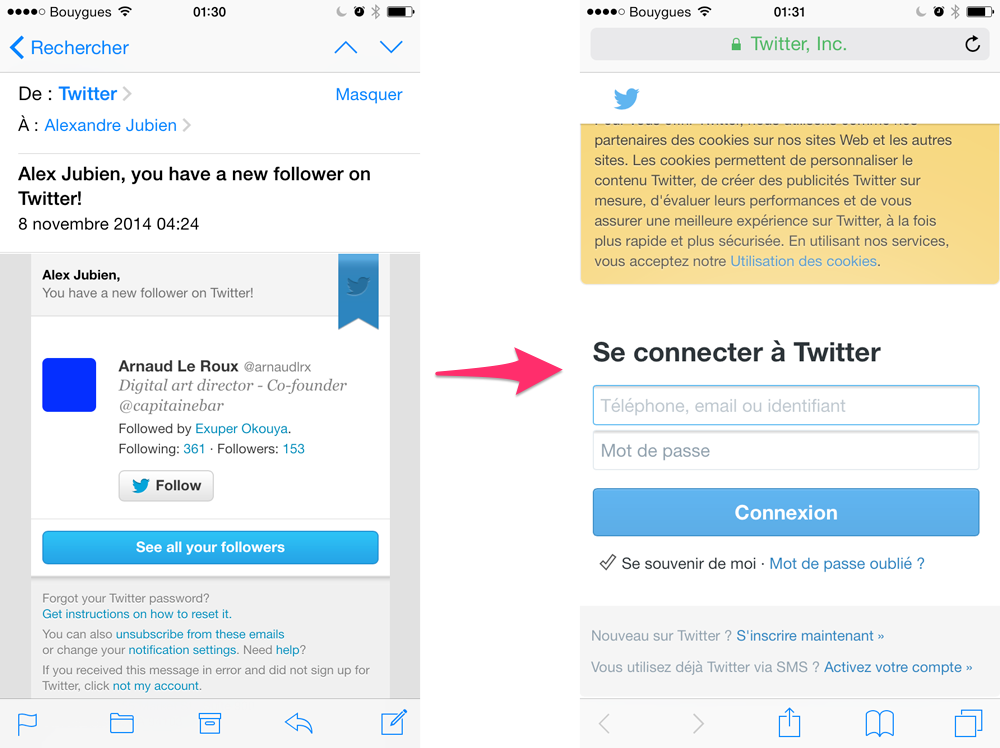
Why does it happen?
In fact, mobile apps and the web as we know it (pages, browsers, email…) are 2 separate worlds.
Just like apps installed on your computer like Word or Excel are very different from websites. And in the begining, mobile apps were meant to be « games and calculators », but not thought primarily to be accessing web contents. Hence the web standards HTML links / HTTP URL don’t work in the apps universe*.
However, the tech mechanism to open an app to a dedicated section or content (called URL Scheme) was there from the very begining, but it’s never been compatible with web standards (HTTP links).

* note that Android apps can capture web links, but this solution is not multi-platform and can lead to bad user experiences (links opened but not handled by apps).
What the Hell is Mobile Deep Linking?
Deep linking reunifies these 2 separate worlds / apps and web, and allows to open apps to specific sections or contents with standard (HTTP) web links.
It uses clever tech mechanisms (details below) to do that, but you’ll be more interested in what it allows. Indeed, since digital marketing channels all rely on web standards, making them work with apps allows you to leverage all your digital marketing efforts also with your app!
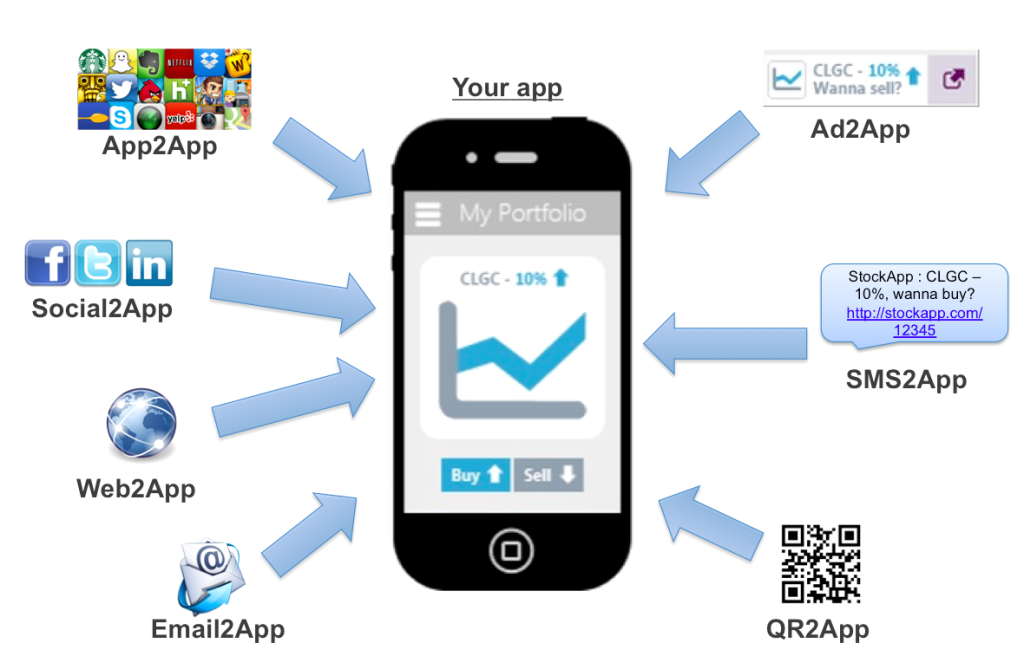
Note that the subject is not new (I was working on that back in 2010 at Deezer!), but it’s currently trending a lot because deep linking is a requirement for retargeting and rich advertising experiences.
The mobile marketing industry realized it’s a major concern, and it seems nowadays every mobile actors provides a deep linking solution.
For Google, Facebook and Twitter, it’s a major concern since having deep linking implemented in all apps means more advertising opportunities – thus revenue growth! That’s why they all invest heavily in this space: Facebook with AppLinks, Google with AppIndexing on Android and Twitter with App Cards.
Want to see by yourself?
How about trying it live by yourself?
Requirements:
- Have an iOS or Android smartphone
- Have the official Twitter app installed
- Have a QR Code scanner on your smartphone if you’re currently reading this article within your desktop browser
If you’re reading this article on mobile:
Just click the links under the QR Codes below, they should open your Twitter app to the right user profile. Try to come back later on this article from desktop to live the full experience!
If you’re reading this article in a desktop browser:
1st, click on this link in your desktop browser. You shall see a dummy standard web page (it could be anything, app landing page or redirect anywhere). If an error popup appears, just ignore it (due to implementation in crappy mode).
2nd, scan a QR Code below with your smartphone. It should open your Twitter app to the right user profile.

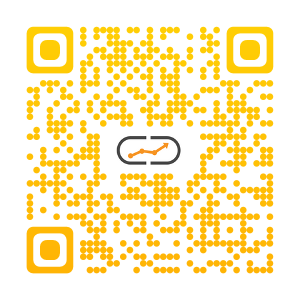
Note that it works everywhere but on mobile it opens the app directly! And in case you did not notice, you’re one button press away to follow me or Apptamin on Twitter ☺
NB: I implemented this experience in quick&dirty mode, so there are a few minor cases in which it might not work for you. It would not happen with a real industrial solution, of course!
How it works
The tech mechanism behind deep linking relies on a simple idea: routing the various cases to their proper solution. Eg, route web browsers to a web page (HTTP URL) and route mobiles to open app (URL Scheme).
And in the meantime, if on mobile and the app is not installed, lead user to install it.
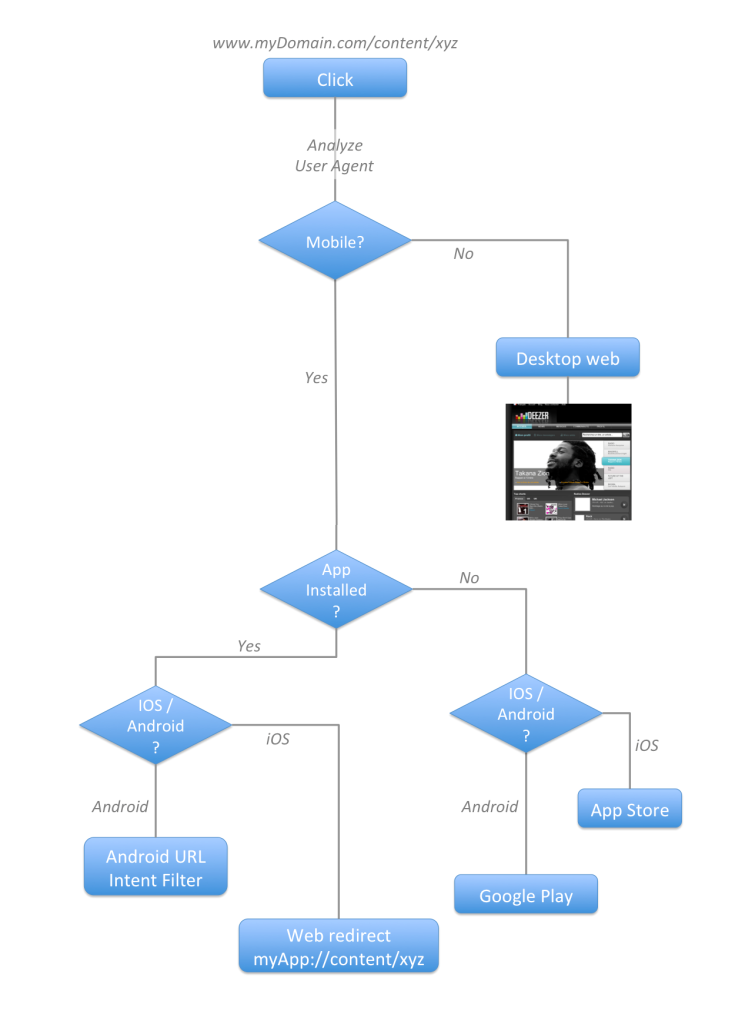
Note that it’s not always possible to detect if an app is already installed, but there are workarounds (more tech details here).
Examples of mobile deep linking done the right way
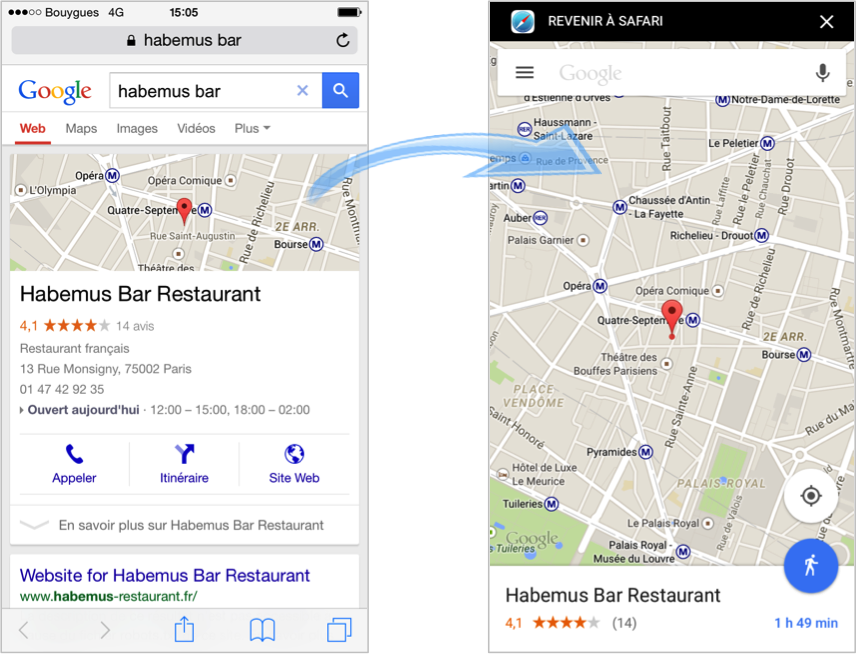
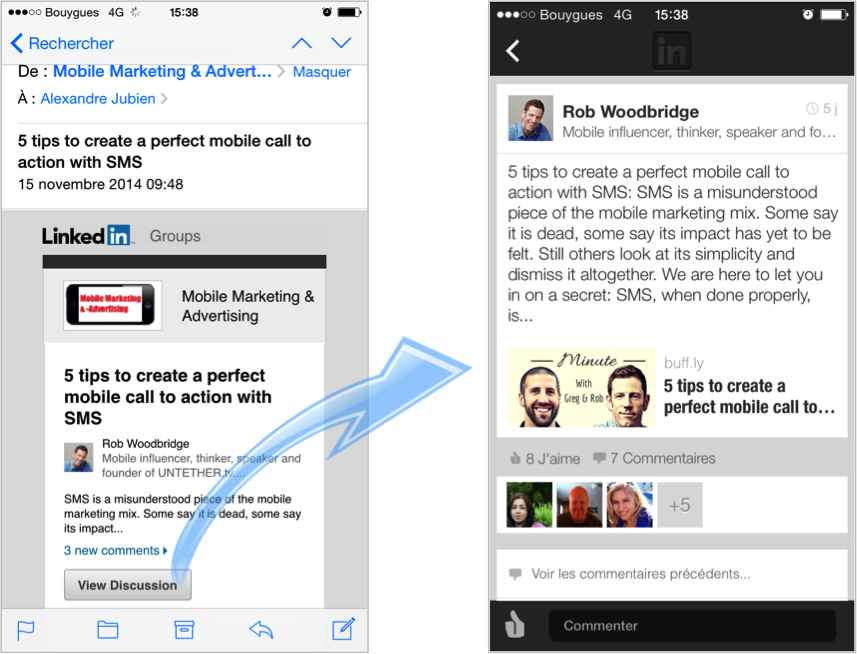
Growth hacking & viral loop
As seen earlier, deep linking will allow users that click links on social media to open the app directly. If your app is content based, you can transform this in a powerful organic acquisition and retention channel.
Viral mechanics based on social networks rely on 2 behaviors of users: production and consumption.
On one side, a small part (say, 10 to 20%) of users share contents on social media, for example by sharing music in the case of Deezer or Spotify. The other users will then consume these shared contents, resulting in more usage of the app (retention). If these users don’t know about the app, it’s a great way to have it discovered and installed (acquisition), particularly since the in-app-content has been shared by a trusted friend.
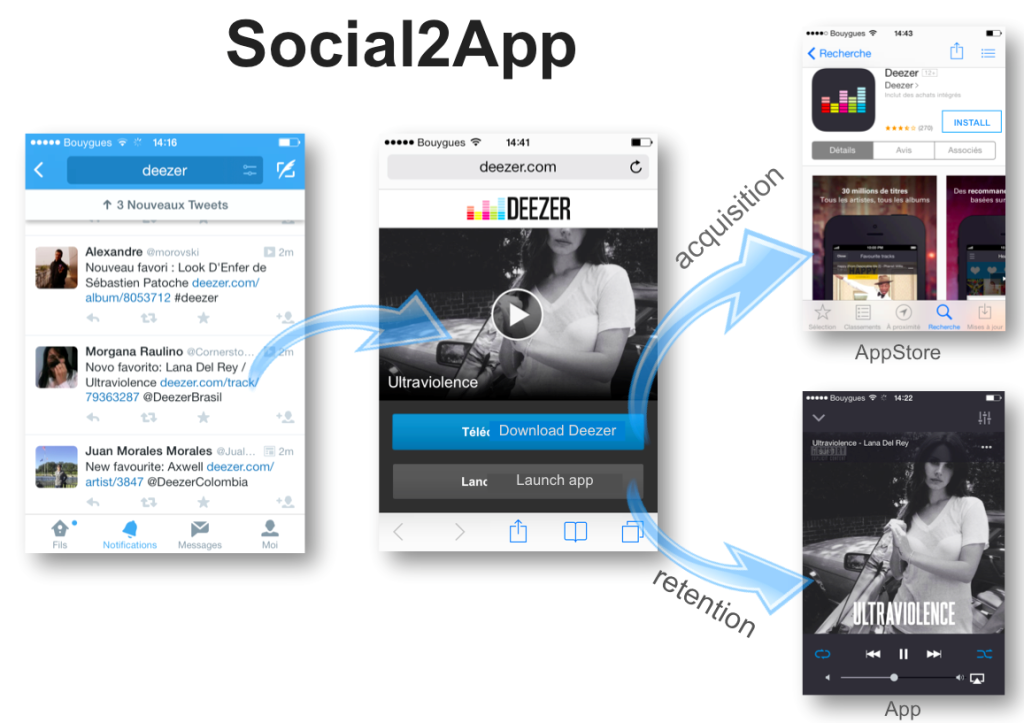
But there’s more: part of these content consumers or new app users will also share content… leading to a viral loop!
Note that Tapdaq made some great articles on viral loops (here and on their own blog), and deep linking is a great ingredient to make things work even better or to remove most of the friction.
You’ll also want to bring in your app more ways for users to share content, or to incentivize them to share. That’s what Deezer and Spotify did early on (2010), by enabling users to link their Facebook accounts and share automatically when they where liking musics, albums or artists in the app.
Just keep in mind that users will look for a “ROI” when sharing. In the case of music services, it’s clearly to make others discover new music or to be recognized as a great music lover (self branding is indeed a common aspiration of users on social networks).
How to build it
Now that you know the What and Why, you’ll probably need some insight on the How.
There are now a few actors that provide out of the box solutions, or you can build it internally.
First of all, ensure you read or transmit to your techies the open initiatives Mobile.Deep.Linking and AppURL.
As for the actors, they’re mostly startups, and here are the most interesting ones in my opinion:
URX Turnpike (see also URX.com – they’re building a search engine that indexes contents in apps), Deeplink.me, Mobile App Tracking, Yozio and Branch.io. Find more Deep linking tools here.
People at Adjust and Appsflyer also have interesting solutions, tackling the tricky part of tracking all the stuff and providing built-in deferred deep linking (an advanced technique that allows the in-app-content to be displayed directly on first launch after install).
And as previously mentioned, there are also the initiatives of the giants: Facebook AppLinks, Google AppIndexing on Android and Twitter App Cards. These are worth supporting on an app marketing perspective, since it’ll enhance your app discoverability and the user experience of the discovery
Finally, if you need to know more about deep linking (including technical details for developers), I strongly recommend that you watch my speech on deep linking at App Promotion Summit (all slides here).
(Une version française de cet article est disponible sur MarketingMobile.co)
***
About the author:
Alex Jubien (@AlexJubien) is a pioneer of mobile apps development that started 12 years ago. Expert in mobile, product and startups he was previously Head of mobile at Deezer (main competitor of Spotify) and Viadeo (main competitor of Linkedin) where he built the mobile teams and apps that are used daily by millions of users. He’s currently independent consultant in mobile strategy, through his company ThinkMobile.
- Engage, Retain, Earn: Growth Strategy for Game Apps [Based on Data] - 15 September 2022
- How to do App Store Optimization step-by-step: a full cycle of ASO in the App Store and Google Play - 9 August 2022
- The Importance of A/B Testing - 13 January 2022


Many of the deep linking tools available are designed for app developers and require SDKs. URLgenius is another deep linking platform with the difference being that the platform is designed for marketers and agencies. You can create deep links to any app for iOS or Android as long as the app has URL schemes. It works like a link a shortner and it’s free to use up to 50,000 clicks per month.
https://app.urlgeni.us
FAQ: https://app.urlgeni.us/faq
Examples for retail apps: https://app.urlgeni.us/blog/deep-linking-ecommerce-mobile-apps
Examples for retail apps: